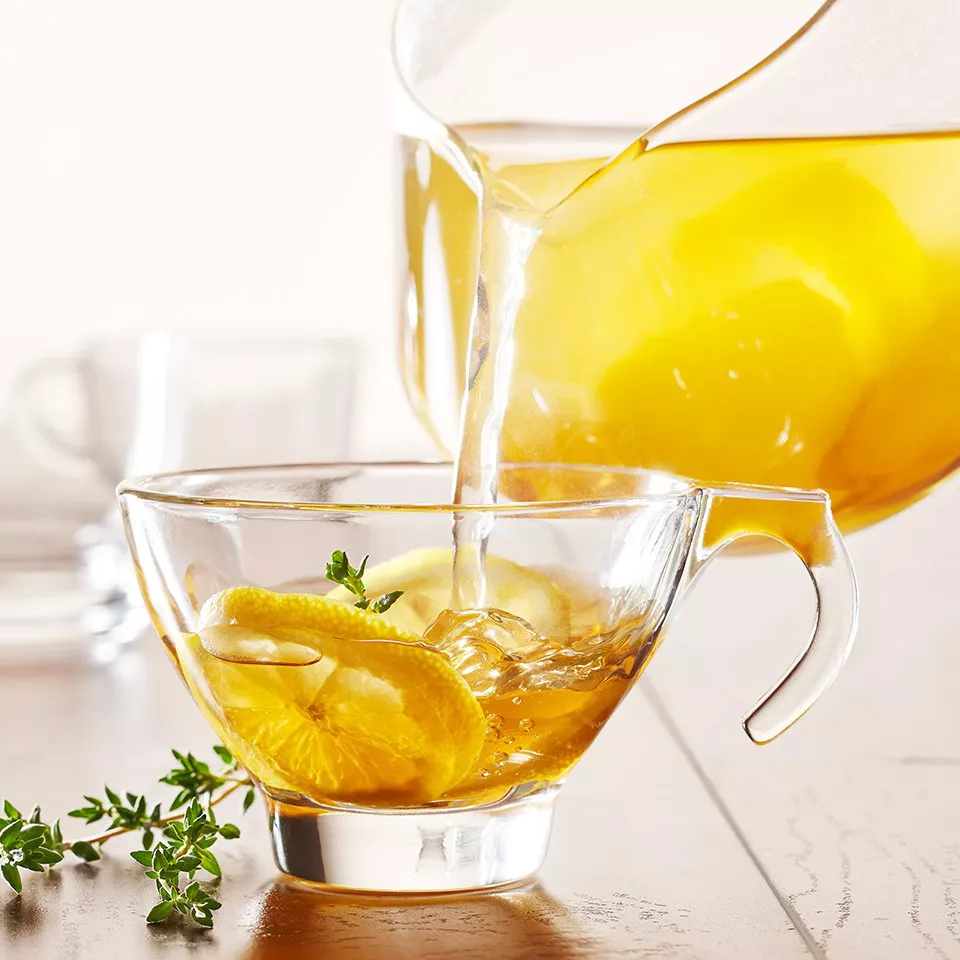6 Best Drinks to Help Lower Your Blood Sugar Levels
It’s not just what you eat that makes a difference in your blood sugar levels—what you drink does too. When you’re looking to lower your blood sugar, it may be obvious to avoid sugar-sweetened drinks, such as soda, fruit juice blends, lemonade and sweet tea, but other drinks go the extra mile by impacting your metabolic function in positive ways. Here are six smart blood-sugar-friendly sips.
1. Water
It’s tough to argue with water since it’s calorie-free. But it also provides something important for blood sugar control: hydration. Drinking plain water is linked to a 6% lower risk of type 2 diabetes, finds a 2021 systematic review and meta-analysis in Diabetes & Metabolic Syndrome: Clinical Research & Reviews. Interestingly, water increases blood volume, which prompts the release of an amino acid that affects blood sugar regulation.
The association is even more powerful when people switch from drinking sugar-sweetened beverages (such as soda) to plain water, since this decreases sugar and calorie intake, helping people maintain a healthy weight, which ultimately helps with blood sugar control. Not into plain H20? Try this Strawberry, Basil & Lime Infused Water.
2. Coffee
Whether you take your cuppa caffeinated or decaf, studies show that drinking coffee regularly is associated with a lower risk of type 2 diabetes, per a 2019 research in the journal Nutrients. Why? Plant compounds, called phytochemicals, in coffee may support the health of cells in the liver and pancreas, which protects against the development of fatty liver and preserves insulin function (a key regulator of blood sugar).
One thing to keep in mind: What you put in your coffee matters. You’ll lose the potential blood sugar benefits if your coffee is a sugar bomb, which is common in flavored lattes and iced coffee drinks. If you don’t like your coffee black, use the dietitian-approved trick to brew your grounds with a few shakes of cinnamon.
3. Black Tea
Not a coffee drinker? Go for tea. It, too, is a drink associated with a lower risk of diabetes and complications from diabetes, per a 2019 review in the journal Antioxidants. Tea compounds help improve insulin resistance and decrease oxidative stress and inflammation. The researchers even say these tea components could be developed into products that could one day help manage diabetes.
Most research is done on black and oolong tea (as well as green tea, more on that below!), so opt for those varietals if you aim to lower your blood sugar. And, just like with coffee, limit adding sugar (including honey). If black tea tastes too bitter, going for tea blends, such as chai (with no sugar added), is a good option. Or for a zero-calorie drink with no sugar, so it remains a good pick for stable blood sugar levels, try this diabetes-friendly No-Sugar-Added Raspberry Iced Tea, which is made with black tea.
4. Green Tea
If you prefer the taste (or lower caffeine content) of green tea, then it’s time to brew up a steaming cup. Consuming green tea has been shown to slightly lower fasting blood glucose levels, per a 2020 meta-analysis of 27 randomized controlled trials published in Nutrition & Metabolism. Tea’s catechins may block some absorption of carbohydrates during digestion, may also improve glucose metabolism, and can lessen oxidative stress, all of which may help bring down your blood sugar.
One caveat? Not all research shows promising results: Another meta-analysis published in 2021 in Diabetes & Metabolic Syndrome did not find that green tea positively affected fasting blood glucose or other blood sugar markers in people with type 2 diabetes. That said, green tea is still a zero-calorie drink with no sugar, so it remains a good pick for stable blood sugar levels.
5. Milk
Though milk alternatives may be trendy, the proteins in cow’s milk may help lower blood glucose response after eating a meal in people who have diabetes and those without, per a 2018 review in Diabetes/Metabolism Research and Reviews. These proteins, including casein and whey, slow digestion and improve insulin response, thereby having a positive effect on blood sugar levels.
Overall, though, more research needs to be done to see how milk consumption might affect A1C levels. The American Diabetes Association recommends choosing nonfat or low-fat milk (which keeps saturated fat in check). Also, milk contains carbohydrates—about 12 grams of carbs per 1 cup of 1% milk, according to the USDA—so make sure you count this in your carb goal for your meal or snack if you have diabetes.
6. Tomato Juice
For a blood-sugar-friendly drink with lots of flavor, sip on tomato juice. In a small randomized controlled trial published in 2020 in the Asia Pacific Journal of Clinical Nutrition evaluating 25 healthy women, those who drank about 7 ounces of tomato juice 30 minutes prior to eating a carbohydrate-rich breakfast experienced a lower blood sugar level after the meal compared to pre-drinking with water. This was even though the tomato juice added extra calories. The fiber in tomatoes may help slow digestion, thus slowing the rise of blood sugar occurring after eating.
Fancy up your tomato juice by adding a celery spear to your glass. And if you want to make a blender veggie juice, try this Tomato-Vegetable Juice.
Other Tips to Manage Your Blood Sugar Levels
In addition to choosing beverages that help lower blood sugar, you’ll also want to follow these tips, according to the Centers for Disease Control and Prevention.
Eat meals and snacks regularly, since going too long between meals can cause your blood sugar to dip.
Keep up an exercise routine. Your muscles soak up glucose (blood sugar) when you’re moving. Walking is an ace at lowering your blood sugar, especially if you do it after meals.
Eat balanced, properly portioned meals. Consuming carbohydrate-rich foods on their own can spike your blood sugar. Eating that same food with healthy sources of proteins and fats lessens your blood sugar response.
The Bottom Line
The best drink to sip for blood sugar management is water. But you can drink more than just H2O. Try coffee, black or green tea or even milk. If you want to get fancy, a small glass of tomato juice will do, too. Just make sure you count the carbohydrates in any beverage for that meal to make sure you stay on track. Bottoms up!














Post Comment